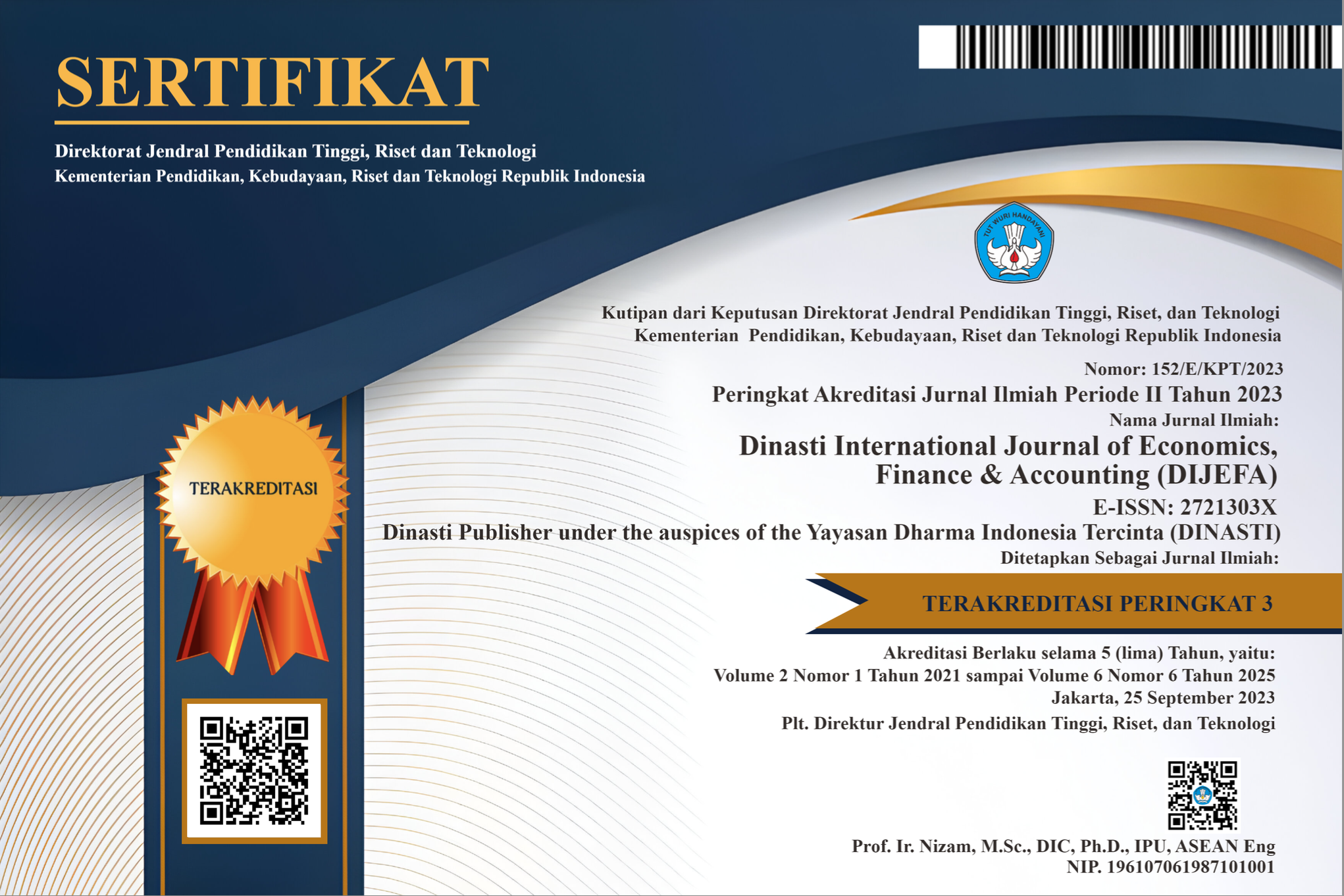Analysis of the Impact of Electronic Money Usage as a Payment Tool on Economic Growth
DOI:
https://doi.org/10.38035/dijefa.v5i6.3617Keywords:
Electronic Money, Payment Tool, Economic GrowthAbstract
This research is conducted for the journal with the aim of analyzing the effects of electronic payment systems based on credit cards, debit cards, and electronic money, as well as macroeconomic variables such as the money supply (M1), price levels, and exchange rates on real gross domestic product (GDP) as a proxy for economic growth. The estimations in this journal use the Vector Error Correction Model (VECM) with monthly time series data for the period from 2012 to 2023. The results indicate that transactions using debit cards and electronic money have a significant positive effect on economic growth in Indonesia in the long term.
References
Akbar, A. (2019). Analisa Perbandingan Transaksi Dengan Menggunakan Uang Elektronik (E-Money) Dan Dengan Menggunakan Kartu Kredit (Studi Kasus Pada Bank Bumn Periode 2010-2015). J. Mandiri, 3(1), 1–19.
Andreas, J., & Hernando, I. (1997). Inflation and economic growth : some evidence for the OECD countries 1 Javier Andrés and Ignacio Hernando. NBER Conference on “The Costs and Benefits of Achieving Price Stability,” 364–385.
Ardiyansyah, H. (2017). Pemgaruh Inflasi terhadap Pertumbuhan Ekonomi Indonesia. Jurnal Pendidikan Ekonomi, 5(3)
Arsyad, L. (2016). Ekonomi Pembangunan (3rd ed.). UPP STIM YKPN.
Bank of International Settlements. (1996). Implications For Central Banks Of The Development Of Electronic Money. Bis, October, 16. BankIndonesia. (2014). Elektronifikasi. https://www.bi.go.id/id/fungsiutama/sistem- pembayaran/ritel/elektronifikasi/default.aspx
BankIndonesia. (2019). Peraturan Bank Indonesia Nomor PBI 16/8/PBI/2014. 4
Basuki, A., & Prawoto, N. (2016). Analisis Regresi Dengan Pendekatan VECM. PT RajaGrafindo Persada, 1–25.
Tiwa, F. R., Rumate, V., & Tenda, A. (2016). Pengaruh Investasi , Suku Bunga Sertifikat Bank Indonesia ( SBI ) Dan Jumlah Uang Beredar Terhadap Pertumbuhan Ekonomi Indonesia Tahun 2005 -2014. Jurnal Berkala Ilmiah Efisiensi, 16(2)
Tumpal Manik, “Analisis Pengaruh Transaksi Digitalisasi Uang Elektronik Terhadap Cashless Society Dan Infrastruktur Uang Elektronik Sebagai Variabel Pemodarasi,” J. Ilm. Akunt. Dan Finans. Indones., vol. 2, no. 2, pp. 27–40, 2019, doi: 10.31629/jiafi.v2i2.1714
Ismanda, F. (2019). Analisis pengaruh APMK dan e-money sebagai instrumenpembayaran non tunai terhadap tingkat suku bunga dan pertumbuhan ekono-mi di Indonesia. Jurnal Dinamika Ekonomi Pembangunan, 2(2), 202-212.
Popovska-Kamnar, N. (2014). The use of electronic money and its impact on monetary policy. Journal of Contemporary Economic and Business Issues, 1(2), 79-92.
Puatwoe, J. T., & Piabuo, S.M. 2017. Financial Sector Development and Economic Growth: Evidence From Cameroon. Financial Innovation, 3(25), 1-18
Tarantang, J., A. Awaliyyah, M. Astuti, dan M. Munawaroh. 2019. Perkembangan Sistem Pembayaran Digital Pada Era Revolusi Industri 4.0 Di Indonesia. 4(1): 67-72
Qoirun, M., Arifin, N., & Oktavilia, S. (2020). Economics Development Analysis Journal Analysis The Use of Electronic Money in Indonesia Article Info. Economics Development Analysis Journal, 9(4).
Mashabi, M., & Wasiaturrahma, W. (2021). ELECTRONIC BASED PAYMENT SYSTEMS AND ECONOMIC GROWTH IN INDONESIA. Jurnal Ilmu Ekonomi Terapan, 6(1), 97.
Zandi, M., Singh, V., Koropeckyj, S., & Matsiras, P. 2016. The Impact of Electronic Payments on Economic Growth. Moody's Analytics. United States: Moody's Analytics
Tee, H. H., & Ong, H. B. (2016). Cashless payment and economic growth. Financial Innovation, 2(1).
M Mashabi. Wasiaturrahma . 2021. Analysis Of Effect Of Electronic Based Payment Sstems And Economic Growth In Indonesia . https://e-Journal.unair.ac.id/JIET/article/view/26287/14649
Mankiw, Gregory. 2007. Principles of Economics, 4th Edition. Thomson Southwestern.
Mankiw, N. Gregory. 2008. Macroeconomics. Fifth Edit. Australia: South-Western Cengage Learning
Mashabi, M. 2019. Analisis Pengaruh Sistem Pembayaran Elektronik Terhadap Pertumbuhan Ekonomi Di Indonesia Periode 2010:1-2018:12 Skripsi
Bank Indonesia. 2004. Penyelenggaraan Kegiatan Alat Pembayaran Dengan Menggunakan Kartu
Bank Indonesia. 2018. Peraturan Bank Indonesia Tentang Uang Elektronik
Gujarati, D. .. 2003. Basic Econometrics. Vol. 82. 4th Editio. New York: McGraw-Hill.
Gujarati, Damodar N., and Dawn C. Porter. 2008. Basic Econometric. Fifth Edit. New York: Douglas Reiner.
Saraswati, Nurma, and Imam Mukhlis. 2018. “The Influence of Debit Card, Credit Card, and E-Money Transactions Toward Currency Demand in Indonesia.”
Suseco, Thomas. 2016. “Effect of E-Money to Economic Performance (A Comparative Study of Selected Countries).” The 2016 International Conference of Management Sciences (No-vember).
Zandi, Mark, Sophia Koropeckyj, Virendra Singh, and Paul Matsiras. 2016. “The Impact of Elec-tronic Financial Payments on Economic Growth.” SSRN Electronic Journal.
Hasan, Iftekhar, Tania De Renzis, and Heiko Schmiedel. 2013. “Retail Payments and the Real Economy.” (15)
Rizani, Ahmad Rizani. 2020. “Analysis of Leading Sectors Pote Analysis of Leading Sectors Po-tential for Economic Development Planning in Bandung City.” Journal of Developing Econ-omies 5(1):16–3
Wasiaturrahma, Wasiaturrahma, Yuliana Tri Wahyuningtyas, and Shochrul Rohmatul Ajija. 2019. “Non Cash Payment and Demand for Real Money in Indonesia.” Journal of Eco-nomics, Business & Accountancy Ventura 22(1):1–8.
Inggrid, 2021. Sektor Keuangan dan Pertumbuhan Ekonomi di Indonesia: Pendekatan Kausalitas dalam Multivariate Vektor Error Correction Model (VECM). Jurnal Ekonomi Manajemen Universitas Kristen Petra.
Kaminsky, Graciela L. and Reinhart, Carmen M., June 1999, ìThe Twin Crises: The Causes of Banking and Balance of Payments Problems.î American Economic Review, 89(3), pp. 473-500.
Mahesa Muhammad.2021. Analisis Transaksi Pembayaran Non Tunai Terhadap Pertumbuhan Ekonomi Di Indonesia. Universitas Brawijaya. https://ekonometrikblog.files.wordpress.com/2016
Downloads
Published
How to Cite
Issue
Section
License
Copyright (c) 2025 Agustina ,, Rinaldi Rustam

This work is licensed under a Creative Commons Attribution 4.0 International License.
Authors who publish their manuscripts in this journal agree to the following conditions:
- The copyright on each article belongs to the author(s).
- The author acknowledges that the Dinasti International Journal of Economics, Finance & Accounting (DIJEFA) has the right to be the first to publish with a Creative Commons Attribution 4.0 International license (Attribution 4.0 International (CC BY 4.0).
- Authors can submit articles separately, arrange for the non-exclusive distribution of manuscripts that have been published in this journal into other versions (e.g., sent to the author's institutional repository, publication into books, etc.), by acknowledging that the manuscript has been published for the first time in the Dinasti International Journal of Economics, Finance & Accounting (DIJEFA).


























































